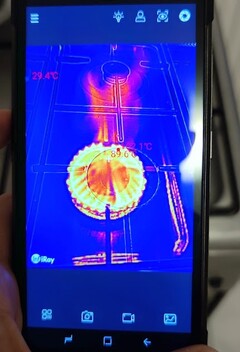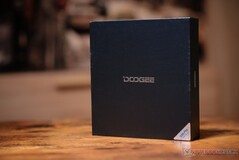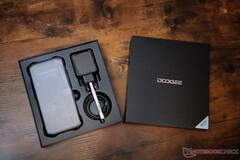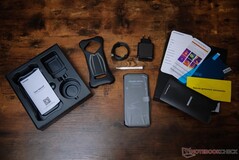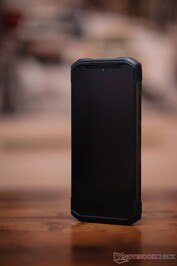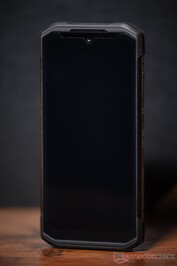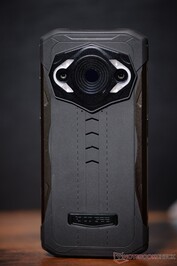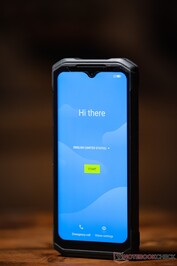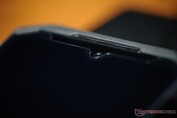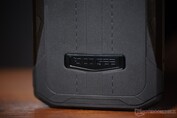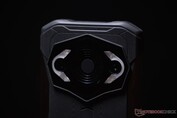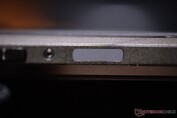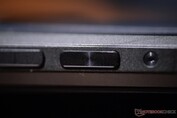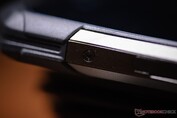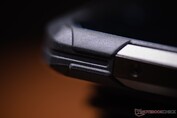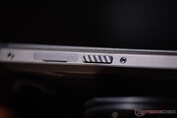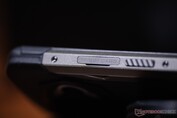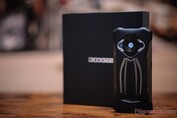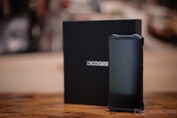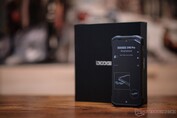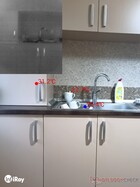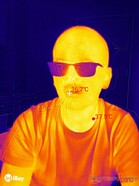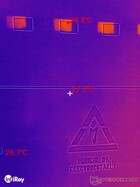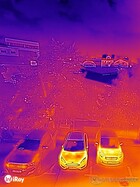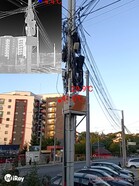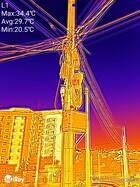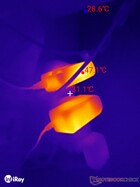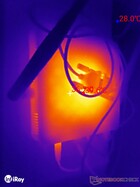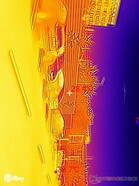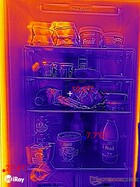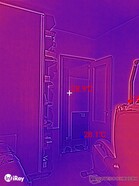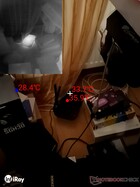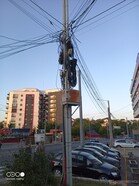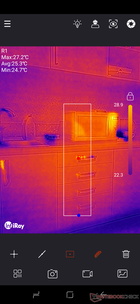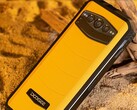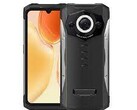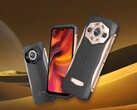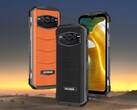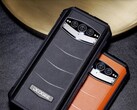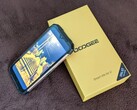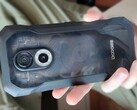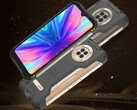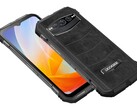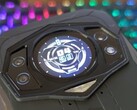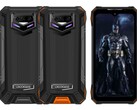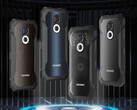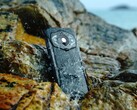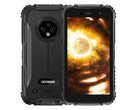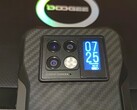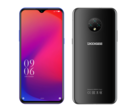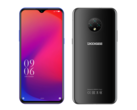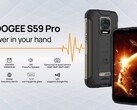Not long after the release of the Doogee S98, the popular rugged phone maker came back with a Pro version that has a lot of things in common with its sibling, but comes with an essential change as well. The change is the secondary display's replacement with a thermal imaging camera. This makes the Doogee S98 Pro a very useful phone for many professionals who need thermal imaging, but provides a rather useful set of tools to less demanding users as well.
Another change worth taking into account from the start is the lack of color choices. However, the Doogee S98 Pro comes bundled with a case that looks quite interesting, although the ruggedness level guaranteed by the handset's compliance with the MIL-STD-810H standard makes it more of a cosmetic accessory than a must-have layer of additional protection. In the end, at least some users will appreciate the ability to change the looks of their handset every once in a while.
Box contents, design, build quality
Unsurprisingly, the retail box of the Doogee S98 Pro is almost identical to that of its sibling. The same goes for the contents of the box, which protects the handset itself and the following accessories: a SIM extractor tool, a USB-C to USB-C cable, a 33 W power adapter, a protective case, an additional screen protector, a bag of accessories (for cleaning and replacing the screen protector), a manual for the thermal imaging capabilities, as well as a basic user manual in 13 languages.
In addition to the above, I also got a pair of alien-shaped sunglasses that arrived in the same package that is not pictured here and is not a part of the standard retail offering (similar to the cosmonaut figure that arrived with the Doogee S98). Obviously, this fashion accessory has nothing to do with the phone and its capabilities and, sadly, it cannot be purchased separately from Doogee.
The Doogee S98 Pro looks and feels almost identical to the Doogee S98 in terms of materials used and the quality of the craftsmanship. However, I must add that the case of the new handset feels just a bit harder than that of the S98. The difference is barely noticeable and shouldn't matter in real-life use.
The SIM tray and buttons are located in the same places as on the Doogee S98, but the S98 Pro has the thermal imaging camera as the central piece of its back panel, replacing the secondary display. The LED flash has a whole new design and is also more powerful.
Last, but not the least, I should mention that the back of the metallic sides has a slightly different design compared to the same part of the Doogee S98. The difference is barely noticeable and has no impact on the ruggedness or weight of the handset.
Specs, features, real-life usage
Without further ado, I will get straight to the specs and features of the Doogee S98 Pro, which uses the MediaTek Helio G96 processor and only comes with 8 GB of memory and 256 GB of UFS 2.2 storage. This generous amount of storage space can be supplemented via a microSD card, if needed. The Doogee S98 Pro comes with the same 6.3-inch LCD FHD+ display with 1080 X 2340 pixels, 60 Hz refresh, and 480 nits typical brightness as the non-Pro S98.
The camera setup consists of a 48 MP main shooter, a 20 MP night vision camera, the InfiRay thermal imaging camera, and a 16 MP selfie shooter. The weight of around 320 grams (a bit more than 0.7 pounds) could be a problem for some people, but this is normal for a rugged phone. Before moving on, I should highlight that the InfiRay thermal imaging camera uses a professional grade sensor with a resolution of 256 X 192 pixels and a 25 Hz frame rate.
While common apps and games ran about the same as on the Doogee S98 (I only played a few games without running any benchmarks and I didn't notice any stuttering or increased loading times), the GeekBench 5.4.4 results for multi-core performance were unexpectedly low, around 1,100 - 1,150 points after multiple runs. The Compute tests did not come with any surprises: 1,414 OpenCL and 1,487 Vulkan points. The storage performance was as good as expected. According to A1 SD Bench, the Doogee S98 Pro's internal storage can hit 474 MB/s when reading data and 449 MB/s when writing.
The Doogee S98 Pro has no problems with signal strength, both indoors and outdoors. Some might say that the lack of 5G is a problem, but in many areas, 5G speed is inferior to 4G speed due to various technical reasons. Things might be different in a few years, but a 4G-only rugged phone should not be considered inferior due to this limitation.
The Android 12 experience is excellent, and the list of extras is short and consists of items like the DuraSpeed app booster, the OutDoor Toolbox suite, and the customization area for the programmable button.
The InfiRay camera has an excellent dedicated app, with quite a few modes of use. The list includes quick, professional, and thermometer modes for the radiometric mode, multiple tools for the professional mode, as well as a straightforward quick mode without any settings. In addition to these, the image mode includes the following: IR only, RGB only, PiP, and MIX-fusion. The results can be quite interesting, as you can see in some of the shots below.
The good, the bad, and the truth
The Doogee S98 Pro comes with a protective case, an option usually not in the cards for rugged handsets. The rest of the positive parts of the non-Pro S98 remain the same: a decent mid-range processor, a generous amount of fast internal storage, 8 GB of memory, a 6,000 mAh battery with wireless charging and fast 33 W wired charging, a clean Android 12 experience, as well as excellent craftsmanship and attractive looks. The side-mounted fingerprint reader remains the same and some might not find it as handy as I do.
While I don't think that the lack of 5G connectivity is a problem in a rugged handset right now, having an AMOLED display on this Pro-labeled device would have been a great idea. Sadly, the Doogee S98 Pro has the same display as the Doogee S98. While not bad for an LCD, it cannot match the image quality of the AMOLED used in the V20 in many scenarios. When using the bundled case, wireless charging is no longer possible.
The thermal imaging camera can help non-professionals with various mundane tasks (checking if the freezer works as it should, checking a person's body temperature, or even finding a cat or dog hiding under a bed or in a drawer at night) and can be a priceless tool for various professionals, such as plumbers or electricians. Even when using the Doogee S98 Pro exclusively as a regular smartphone, having a thermal imaging camera at hand can be very useful, even life-saving in some cases. Considering the price of such cameras, having one integrated in a handset that can be purchased for roughly US$500 (the price might vary depending on market, retailer, and various deals that might be active)
Disclaimer: The author of this review received the Doogee S98 Pro rugged smartphone from Doogee free of charge for the purpose of testing.
Source(s)
Doogee (official product page)


 Deutsch
Deutsch English
English Español
Español Français
Français Italiano
Italiano Nederlands
Nederlands Polski
Polski Português
Português Русский
Русский Türkçe
Türkçe Svenska
Svenska Chinese
Chinese Magyar
Magyar